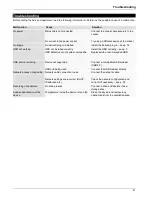
Drive
27
RAID
Click on “RAID” to go to the settings.
Here is an overview of the terms that are important for
creating a RAID:
Text
Explanation
RAID
R
edundant
A
rray of
I
ndependent
D
isks
RAID Level 0
A RAID 0 array consists of 2 HDDs
with the identical capacity.
With RAID 0, the data is written to
both disks alternately. This has
performance benefits for every write
and read operation. If a disk fails, all
the data is lost.
RAID Level 1
A RAID 1 array usually consists of
2 HDDs containing the same data
(“
mirroring”
). RAID 1 provides full
redundancy for the stored data, while
the capacity of the array is, at the
most, that of the smallest participating
HDD. If a HDD fails, it can be
replaced during operation.
RAID Level 5
A RAID 5 array consists of at least 3
HDDs. The redundancy information is
distributed among individual HDDs so
that the data on a HDD that fails can
be reconstructed from the information
stored on the other disks (“parity
striping”). With
n
individual disks of
the same size, the total capacity is n-
1 times that of an individual disk.
RAID Level 10
For this array, 4 HDDs are required.
They must all have the same
capacity. Here the performance
benefits of RAID 0 are combined with
the data security of RAID 1. Two
HDDs run in the RAID-0 mode to
enable the performance, and the
other two HDDs run in RAID 1 mode
to ensure the data security. If one of
the four HDDs now fails, all the data
can still be read, and the system can
go on being used.
The following section summarises the advantages and
disadvantages of the respective RAID level:
RAID
level
Performance Data security
Capacity
0
+100%
0%
100%
1
0%
100%
50%
5
+250%
100%
80%
10
+100%
100%
50%
Preparations:
Install all the drives in the 16-channel NAS.
Note
Please see the information on installing the HDDs
on page 7.
When all the HDDs have been installed and the 16-
channel NAS has been started, the HDDs are detected
automatically and are available for selection when
creating a RAID.
Note
To achieve optimal performance, only use HDDs
of the same type and capacity.
















































